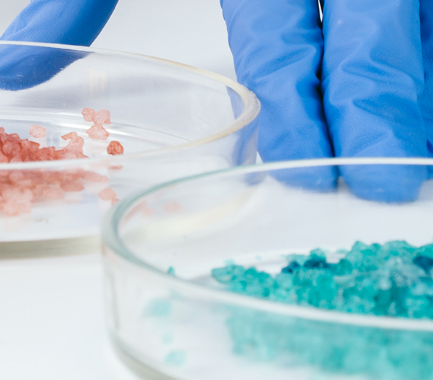Your contact
PENPET-Team - Hamburg

Laurens Rogowski
Sales
Tel. +49 (0) 40 - 675 7 99 80
sales@penpet.de
Get in touch with us.
Tetrahydrophthalic anhydride (THPSA)
Tetrahydrophthalic anhydride (THPSA) is an organic substance from the group of carboxylic acid anhydrides that is used in the chemical industry, primarily for the production of plastics and synthetic resins. It is obtained in a Diels-Alder process by reacting maleic anhydride with butadiene.
The compound serves as a base material for the production of polyester resins, acrylic resins and alkyd resins as well as plasticizers for plastics and hardeners for epoxy resins. In addition, adhesives, fungicides and insecticides are manufactured on the basis of tetrahydrophthalic anhydride. The substance also serves as a starting point for the synthesis of tetrahydrophthalic acid, tetrahydrophthalimide and other important intermediates for the chemical industry.
At PENPET you can easily and reliably order the required amount of tetrahydrophthalic anhydride (THPSA). We look forward to receiving your inquiry for an individual offer. The solids can be delivered in 25 kg sacks and in Bag Bags of 500 kg, 800 kg or 1000 kg.
Other individual packaging is also available on request.
CAS no. 85-43-8
EINECS no. 201-605-4
Molecular formula: C8H8O3
Synonyms: 4-cyclohexene-1,2-dicarboxylic anhydride, 1,2,3,6-tetrahydrophthalic anhydride, THPSA, THPA
Areas of application: Manufacture of synthetic resins, plasticizers, hardeners for epoxy resins, insecticides, fungicides and adhesives, intermediates for synthesis processes in the chemical industry
More Information
Tetrahydrophthalic anhydride (THPSA) is structurally similar to phthalic anhydride, from which it differs by having four additional hydrogen atoms and a smaller number of unsaturated bonds. The substance has a cyclic structure of six carbon atoms linked by five single bonds and one double bond. Two dehydrated carboxylic acid groups are attached to two adjacent carbon atoms of this hexene group, which are linked via a common oxygen atom and thus form a further cyclic unit. The alternative designation 4-cyclohexene-1,2-dicarboxylic acid anhydride explains the structure of the substance. The compound exists in two isomeric forms, which differ slightly in the spatial arrangement of their components.
Due to the fact that the hexene ring is not aromatic, but slightly unsaturated, tetrahydrophthalic anhydride can enter into addition reactions and accept further hydrogen atoms. As a carboxylic acid anhydride, it can be converted into the corresponding carboxylic acid by absorbing water, resulting in tetrahydrophthalic acid.
Tetrahydrophthalic anhydride (THPSA) is a white to yellowish solid and occurs as a crystalline powder or as fine flakes. The compound is almost odorless. It is only slightly soluble in water and reacts violently on contact with it. However, the substance is readily soluble in organic solvents such as acetone, benzene and ethyl alcohol. Tetrahydrophthalic anhydride melts at temperatures around 100 °C and changes to the gas phase at 195 °C and above.
Tetrahydrophthalic anhydride (THPSA) is chemically stable when stored in a dry, airtight environment. The connection must be protected against moisture. It already reacts with the humidity in the air, but also with water vapor and water, generating a lot of heat. This produces hot vapors of caustic tetrahydrophthalic acid, which spread through the room as an acrid mist and represent a significant health hazard. Tetrahydrophthalic anhydride also reacts violently with strong oxidizing agents, strong acids and strong bases, developing a great deal of heat. When storing, it should also be noted that the compound has a corrosive effect on metals, which can result in the formation of explosive hydrogen.
Tetrahydrophthalic anhydride is combustible and can form an explosive atmosphere if heated above 157°C. Since the vapors from the substance are heavier than air, they can spread unnoticed along the ground. Remote ignition by vapors from the compound is therefore possible. Their dust is also a source of danger, because the turbulence of fine particles can create explosive dust-air mixtures with the ambient air. Tetrahydrophthalic anhydride must therefore be kept away from ignition sources such as welding and grinding sparks, electrical devices, hot surfaces and open flames. Burning and heating the compound will produce carbon monoxide and other hazardous gases.
Tetrahydrophthalic anhydride (THPSA) reacts on contact with moisture to form tetrahydrophthalic acid, which is highly corrosive. The compound is a skin hazard that can cause severe irritation, allergic reactions, and persistent skin sensitization. Due to its corrosive effects, it can cause serious and irreversible damage to the eyes, which can lead to permanent impairment or loss of vision. Affected parts of the body should be rinsed immediately with water and treated by a doctor.
Inhalation of vapors and dusts of the substance leads to irritation of the mucous membranes, coughing and breathing difficulties and can trigger asthmatic and allergic reactions. If tetrahydrophthalic anhydride is swallowed, serious injuries to the esophagus and stomach can occur in addition to irritation of the gastrointestinal tract and gastrointestinal symptoms. To dilute the acid and mitigate the danger, copious amounts of water should be drunk after rinsing the mouth thoroughly. Medical treatment must be arranged.
Tetrahydrophthalic anhydride is harmful to aquatic organisms and has been assessed as a low water hazard that should not be allowed to enter soil, wastewater or open water. The competent authorities must be informed of the escape of large quantities of tetrahydrophthalic acid.
